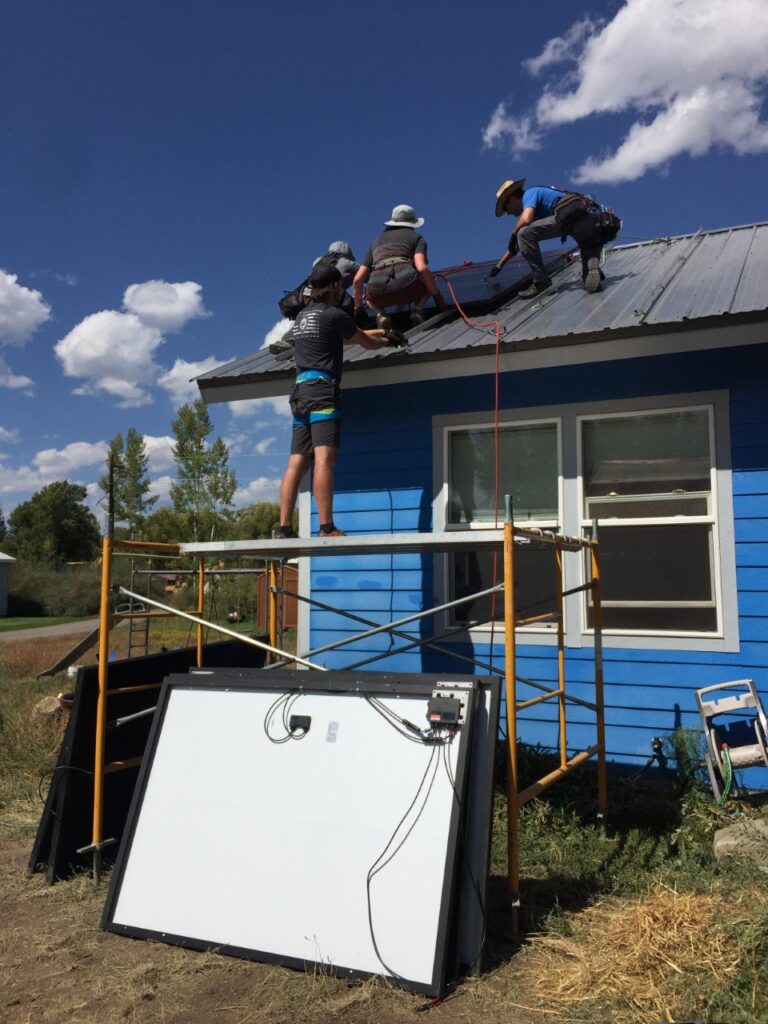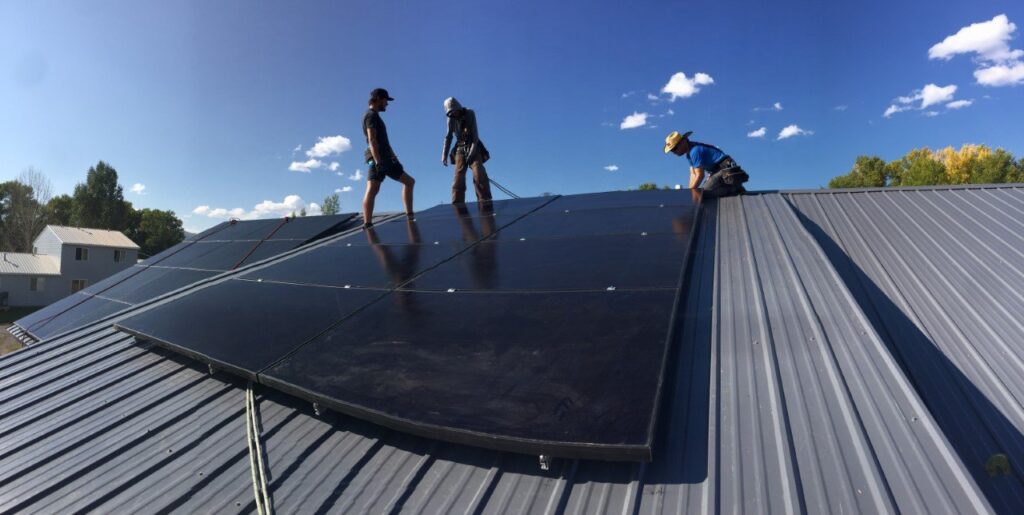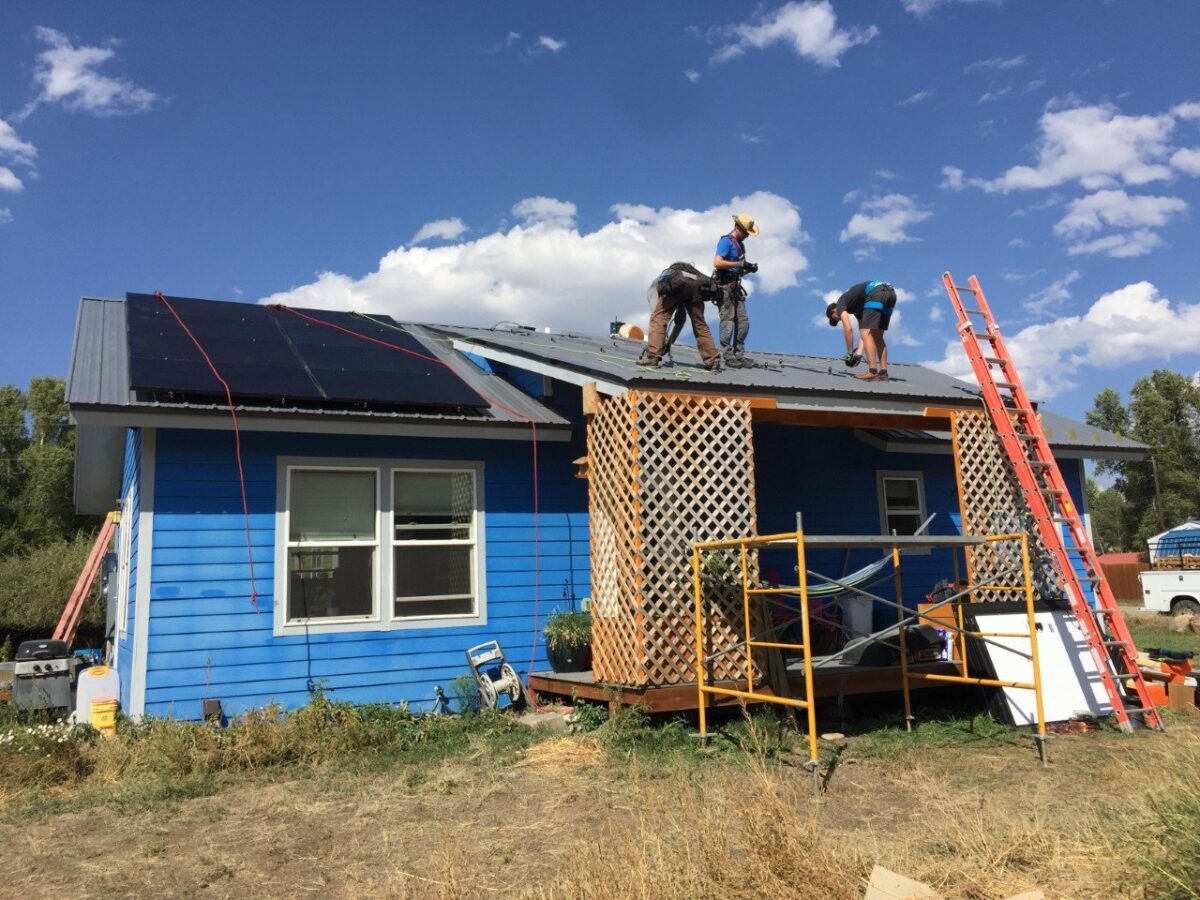
Western Solar Society (WSS) is a new student organization at Western that works to install solar energy systems that advance sustainability, accessibility, and equity, both on campus and within the Gunnison community. The club was first spawned out of Western’s Environment and Sustainability (ENVS) 301 course, taught in fall 2020 by Professor Rich Stromberg. Professor Stromberg also serves as the director of Equitable Solar Solutions (ESS, a program of the Western-linked nonprofit Coldharbour Institute) and is a doctoral candidate at the University of Alaska-Fairbanks.
As part of Profesor Stromberg’s class, students were split into two project groups. One of the groups was tasked with acquiring and installing energy sensors to examine the solar output from Kelley Hall’s rooftop solar system. The other group examined the efficiency of that building’s photovoltaic water heating system. To support their projects, the two groups sought and obtained funding from the Sustainability Fund, which is administered by Western’s Sustainability Action Committee (SAC).
The energy monitoring system will have been in place for one year come Nov. 2021. The system looks at the building’s total energy consumption with an eye towards systemic inefficiencies. Throughout the monitored time period, roughly 15 to 17 percent of Kelley’s energy needs have been met by its rooftop solar setup, with a lower output in the winter (due to snow cover) and higher production in the summer with more direct sunshine. Matt Harris, a junior in the ENVS program and the club’s current vice president, notes that this information is key to quantifying the solar resources required to reach 100% renewable energy for the building down the line.
After the ENVS 301 projects and class wrapped up, a tight knit group of students began planning a campus club to focus on expanding solar energy systems locally, spurred in part by stir craziness around Covid restrictions. They utilized the 2021 spring semester to focus on marketing and building involvement. As part of these efforts, they hosted the inaugural “Battle of Watts” solar golf cart race on campus during Earth Week.
The club’s officers: Taylor Schultz (ENVS), Kallie Klein (ENVS), Jordyn Jiminez (a converted Business to ENVS major), and Matt Harris (ENVS), formally launched the Western Solar Society (WSS) in the fall of 2021 with dedicated funding from the Student Government Association (SGA).
The Western Solar Society is now one of just 10 official campus chapters of the American Solar Energy Society (ASES), a nonprofit renewable energy outreach and education organization active since 1954. WSS recently collaborated with ASES on a Gunnison solar tour publication, an educational tool with details and locations of installed solar projects around town. Many of ASES’s other active university chapters are large state schools and elite private institutions, making Western’s involvement all the more special.
Harris notes that the club hit the ground running thanks in large part to club advisor Rich Stromberg, who has ample connections within the community. “He has lined up a bunch of amazing opportunities for us that we can just grab hold of,” notes Harris.
One of those opportunities was a solar installation project in concert with Gunnison Valley Habitat for Humanity (GVHFH). More than a half dozen WSS members, in conjunction with three ESS interns and Professor Stromberg, installed a solar array on the roof of a house on 6th street where Habitat for Humanity is working on a row of homes. The panels for that project came via a donation from Coldharbour Institute.
“None of us had ever done anything like that before, and it’s a total practical application,” Harris noted. The work took place over the span of three days. “It was a pretty fun process, actually having to rope up on the roof and maneuver around,” said Harris.
Harris admitted it was a bit intimidating looking at all the wiring initially, but that the system was fairly simplistic and intuitive once they started putting it together. WSS is hoping to install another solar array on the newest house along the row of Habitat for Humanity properties soon. The house that will receive the panels is currently under construction.

WSS is also working on a campus solar lighting pilot project, which will hopefully help address Western’s campus lighting issues. This project rose to the top of the pile after SGA conducted a campus safety survey last year. That survey identified lighting as a salient issue in urgent need of an upgrade. A campus committee focused on addressing lighting, security cameras, and other related safety issues has been formed this year to investigate potential remedies.
Western’s lighting issues boil down to two primary aspects: the lights currently in place are not bright or reliable enough to meet the need, and some areas of campus simply are not covered adequately by the current lighting system.
WSS went to speak with SGA regarding campus safety this fall, and learned that there are brewing plans to bolster campus lighting within the next several years, sparking an urgency within WSS to undertake a pilot lighting project and prove that these solar lights could solve Western’s problems.
The club then went to the Facilities Department for approval to decommission two lighting structures and implement their pilot program. They found Facilities to be an enthusiastic supporter of their plans. They also learned that the department is aiming to start replacing the existing lighting systems within the next few years, providing a clear window for possible project expansion in the near future.
Western Solar Society turned to Western’s Sustainability Fund with a modest proposal for their pilot lighting system, signage to accompany the lights, and funds to obtain feedback on their effectiveness via a brief survey intended for students. The group’s pilot project will compare a 6000 lumen lighting model to a 14,000 lumen model. The two lights will be activated via motion sensors.
It is difficult to project when the ordered equipment will arrive, but Harris would like to get the systems up-and-running by November so that the pilot can start when it’s a bit warmer and then run through February when Gunnison is at its darkest and coldest. Harris adds that if the lights can last through the evening until 5 or 6 a.m. maintaining the desired brightness, then the Western Solar Society will be able to return to Facilities and SGA with a proven model of success for future lighting upgrade projects.
Other than their ongoing lighting and installation projects, WSS is also looking to expand and diversify their student membership. Currently, they have four club officers on their team, including ENVS and 3+2 Master’s in Environmental Management student and club president Taylor Schultz, who worked as an ESS intern last spring.
As part of that internship, Schultz worked on a prototype of a charging station for wheelchairs. She noted that knowing the prototype’s user was able to get around on outdoor trips by making use of the solar charger was deeply meaningful to her. Schultz was primarily interested in water conservation and management throughout her undergraduate studies at Western.
But then, circumstances aligned for her to work with Professor Stromberg at ESS, and to head up WSS, she has found a new passion in renewable energy projects. “The things we’re doing are very tangible. We can see results”, says Schultz, who is eagerly looking ahead to more projects in the energy sphere.
One area for improvement is the boiler in Kelley Hall, which is not designed to work efficiently with the building’s solar power. That issue could be solved by installing a new component, a project WSS may work on this winter as the weather turns and prospects for other projects diminish until spring.
Schultz says she is driven in her work around solar energy as a tool for advancing equity and justice, and for changing people’s perceptions of Western and the community at-large. Schultz notes that working with Habitat for Humanity to build clean, accessible housing for a family was an amazing antidote to the oftentimes gloomy world of environmental science. Obtaining that sense of social responsibility and actively remaking your community in a more sustainable and equitable way is a big part of why Schultz wants more students to get involved with WSS.
Looking ahead, the Western Solar Society will work with Equitable Solar Solutions to install a charging station for motorized wheelchairs and e-bikes on the University Center’s south patio. WSS would also love to expand their ranks further beyond the ENVS program and expand their club size and capacity to take on more projects on campus, and in the greater Gunnison community. As part of this effort, the club will maintain a presence at Campus Preview Day on Oct. 29, and at the Headwaters Conference the first weekend in November.
If you are interested in getting involved, the Western Solar Society (WSS) meets on Tuesdays at 5:30 p.m., typically in the Kelley Hall fireside lounge (subject to change). You can also get on their email list by emailing solarsociety@western.edu


